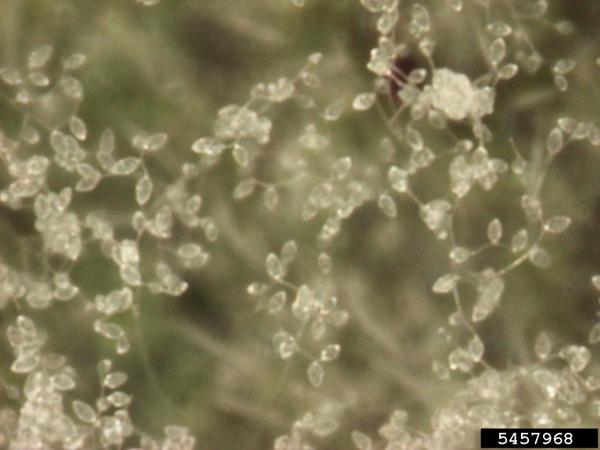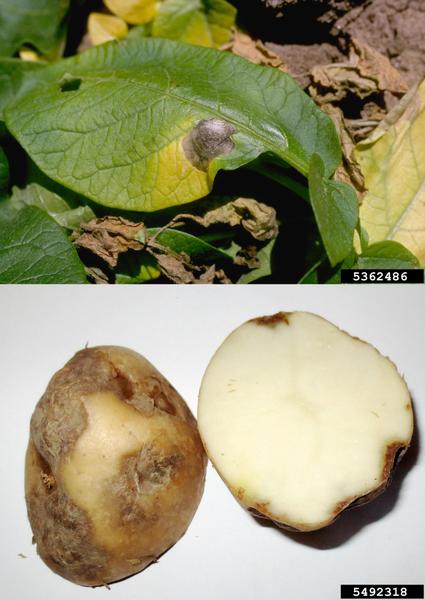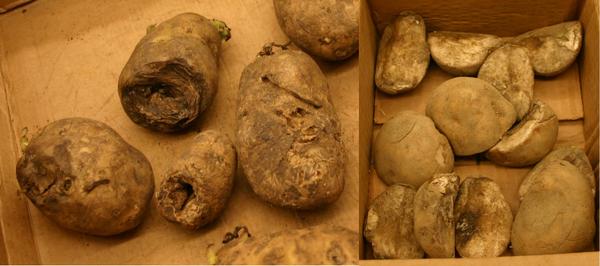Pathogen
Potato late blight is caused by the oomycete pathogen Phytophthora infestans (P. infestans). The pathogen is best known for causing the devastating Irish potato famine of the 1840s, which killed over a million people, and caused another million to leave the country.
Host Crops and Plants
Solanaceous plants such as potato, tomato, petunia and nightshade, but the disease is economically important mainly in potato and tomato.
Host Parts Affected
All above-ground portions of the plant and tubers, but the disease is usually first recognized by its foliar symptoms.
Identification
The pathogen causes purple to brown, sunken, dry lesions on the surface of tubers that extend into the tuber (Figure 1). Tissue inside the tuber, under the surface of lesions turns brown and granular. Infected tubers frequently develop secondary bacterial soft rots. Brown to gray water soaked lesions occur on stems (Figure 1) and leaves (Figure 2 and Figure 3). Leaf lesions usually begin on the edges, are circular and have yellow to pale green borders. When conditions are favorable, for example early in the morning when the moisture is higher, lesions observed from the underside of the leaf may be covered in mycelia or white spores called sporangia, especially at the edges of the lesion (Figure 4).
Identification of potato late blight can be difficult since symptoms resemble other diseases, but spores and mycelia on the underside of the leaf can provide additional evidence of the pathogen. Sporangia can be seen in the field with a 20X hand lens when weather conditions are favorable. Sporangia contain 20-30 smaller swimming spores called zoospores that travel through water to infect plants. Both sporangia and zoospores can germinate to produce the pathogen.
Similar Diseases
Potato late blight is often confused with other foliar and tuber diseases such as early blight and Fusarium dry rot.
Favorable Environmental Conditions for the Disease
- High-humidity and moisture (6–12 hours of moisture are ideal and usually occur as morning dew, rain, or overhead irrigation).
- Moderate temperatures (~60–80°F).
- In North Carolina, disease typically begins in June and lasts throughout the growing season.
Disease Transmission
The pathogen usually needs a living host to overwinter; it survives on infected tubers placed in storage, cull piles and volunteers. However, it can also survive in soil and plant debris by forming oospores, which are thick-walled overwintering spores that are formed when both mating types (A1 and A2) of the pathogen are present in a field. Pathogen spores can be transported from state to state through air currents. Spores come to North Carolina from surrounding states every year. Tubers become infected when rain or irrigation wash down sporangia from leaves with sporulating lesions and zoospores swim through the soil to infect the tuber.
General Disease Management
- Use pathogen-free seed
- Plant early in the season to escape high disease pressure
- Do not allow water to remain on leaves for long periods of time
- Scout plants often and remove infected plants, infected tubers, volunteers and weeds
- Clean tools and equipment after leaving a field
- Sign up to receive alerts at the USAblight website
- Keep tubers in storage dry and at low temperatures (38°F)
- Plant tolerant varieties when possible
- Protect the crop with fungicides
Disease Control for Conventional Growers
Before disease occurs, apply fungicides at 7-10 day intervals. After disease is detected in your area, apply fungicides at 5-7 day intervals. Alternate products and tank mix mancozeb or chlorothalonil to avoid generating fungicide-resistant strains. For the latest fungicide recommendations for potato late blight see the Southeastern US Vegetable Crop Handbook. Fungicide labels are legal documents, always read and follow fungicide labels.
| Active ingredient | Example product | PHI (day) | Group |
|---|---|---|---|
| Cyazofamid | Ranman 3.6SC | 0 | 21 |
| Ametoctradin + dimethomorph | Zampro | 4 | 45+40 |
| Oxathiapiprolin | Orondis Opti A | 5 | U15 |
| Dimethomorph | Forum | 4 | 40 |
| Cymoxanil | Curzate 60DF | 14 | 27 |
| Mefenoxam | Ridomil Gold | 14 | 4 |
For example, before disease you can use: Forum, or Curzate, every seven days in rotation. After disease you can use: Ranman, or Orondis Opti A, or Zampro every five days in rotation.
Disease Control for Organic Growers
Organic growers have less chemical options that are effective; the only OMRI labeled active ingredients that have decent efficacy against late blight are fixed copper formulations.
Disease Control for Home Gardeners
Products containing the active ingredients copper or chlorothalonil (the trade name of one product with chlorothalonil is known as ‘Daconil’) are the best and only effective products available to home gardeners. In addition, home gardeners should grow varieties with resistance if they are worried about late blight in future years because most chemicals available to the home gardener are not sufficient to control late blight once it appears. Once plants are infected in a home garden, there is little that can be done to protect them besides weekly fungicide sprays.
Useful Resources
- The North Carolina State University Plant Disease and Insect Clinic provides diagnostics and control recommendations
- USAblight provides forecasts and reports of disease outbreaks
- The Extension Plant Pathology Portal provides information on crop disease management
- The Southeastern US Vegetable Crop Handbook provides information on vegetable disease management
- The USDA Fungus-Host Distributions Database provides information about reported hosts for fungal and oomycete pathogens
Acknowledgements
This factsheet was prepared by the North Carolina State University Vegetable Pathology Lab in 2014.
Publication date: Jan. 22, 2018
Reviewed/Revised: Jan. 9, 2023
Recommendations for the use of agricultural chemicals are included in this publication as a convenience to the reader. The use of brand names and any mention or listing of commercial products or services in this publication does not imply endorsement by NC State University or N.C. A&T State University nor discrimination against similar products or services not mentioned. Individuals who use agricultural chemicals are responsible for ensuring that the intended use complies with current regulations and conforms to the product label. Be sure to obtain current information about usage regulations and examine a current product label before applying any chemical. For assistance, contact your local N.C. Cooperative Extension county center.
N.C. Cooperative Extension prohibits discrimination and harassment regardless of age, color, disability, family and marital status, gender identity, national origin, political beliefs, race, religion, sex (including pregnancy), sexual orientation and veteran status.






